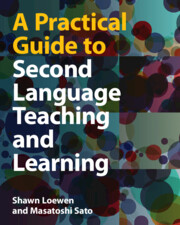Book contents
- A Practical Guide to Second Language Teaching and Learning
- Reviews
- A Practical Guide to Second Language Teaching and Learning
- Copyright page
- Dedication
- Contents
- Figures
- Tables
- Preface
- Acknowledgments
- 1 Language Acquisition
- 2 Second Language Acquisition
- 3 Instructed Second Language Acquisition
- 4 Input, Interaction, and Output
- 5 Grammar
- 6 Vocabulary
- 7 Pronunciation
- 8 Pragmatics
- 9 Academic Language Skills
- 10 Cognitive Individual Differences
- 11 Psychological Individual Differences
- 12 Social Individual Differences
- 13 The Research–Practice Dialogue
- Key Terms
- Index
- References
3 - Instructed Second Language Acquisition
Published online by Cambridge University Press: 03 May 2024
- A Practical Guide to Second Language Teaching and Learning
- Reviews
- A Practical Guide to Second Language Teaching and Learning
- Copyright page
- Dedication
- Contents
- Figures
- Tables
- Preface
- Acknowledgments
- 1 Language Acquisition
- 2 Second Language Acquisition
- 3 Instructed Second Language Acquisition
- 4 Input, Interaction, and Output
- 5 Grammar
- 6 Vocabulary
- 7 Pronunciation
- 8 Pragmatics
- 9 Academic Language Skills
- 10 Cognitive Individual Differences
- 11 Psychological Individual Differences
- 12 Social Individual Differences
- 13 The Research–Practice Dialogue
- Key Terms
- Index
- References
Summary
This chapter focuses on instructed second language acquisition research that examines second language learning specifically in instructional contexts, broadly construed (e.g., classrooms, online learning, self-study). The scope of the research field is discussed by distinguishing it from broader second language acquisition research. In essence, the chapter addresses the primary question that researchers and teachers are interested in: Can instruction help learners develop their second language proficiency? The chapter then answers the follow-up question which is: Which types of instruction are more or less helpful? In answering this question, the chapter considers the goals that learners and other stakeholders, such as teachers and parents, have for their second language development. It discusses different types of second language knowledge (implicit and explicit knowledge) as the goal of second language instruction. Finally, the chapter explores pedagogical issues and ends by considering a taxonomy that describes various approaches and methodologies to second language teaching.
Keywords
Information
- Type
- Chapter
- Information
- Publisher: Cambridge University PressPrint publication year: 2024
